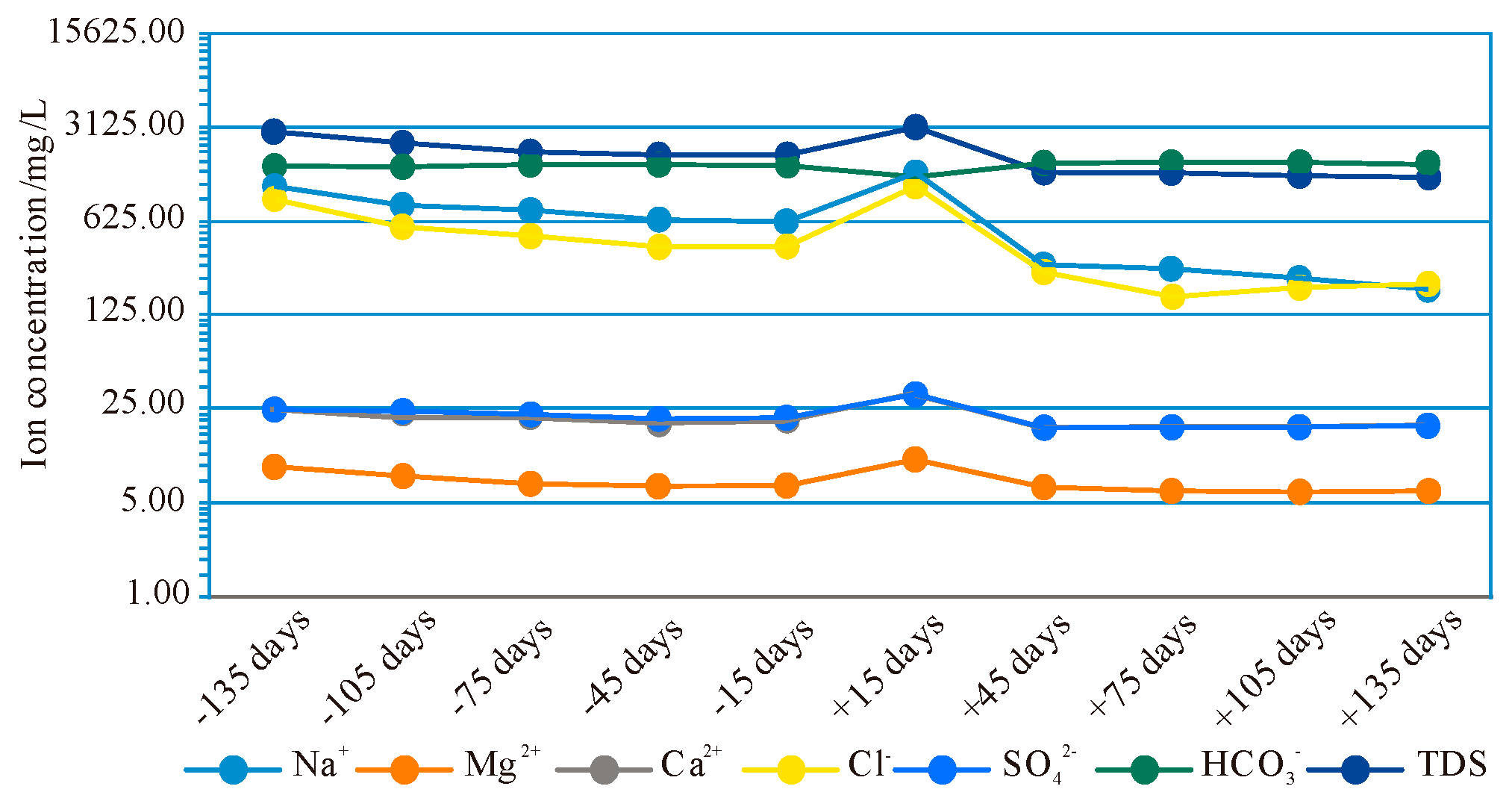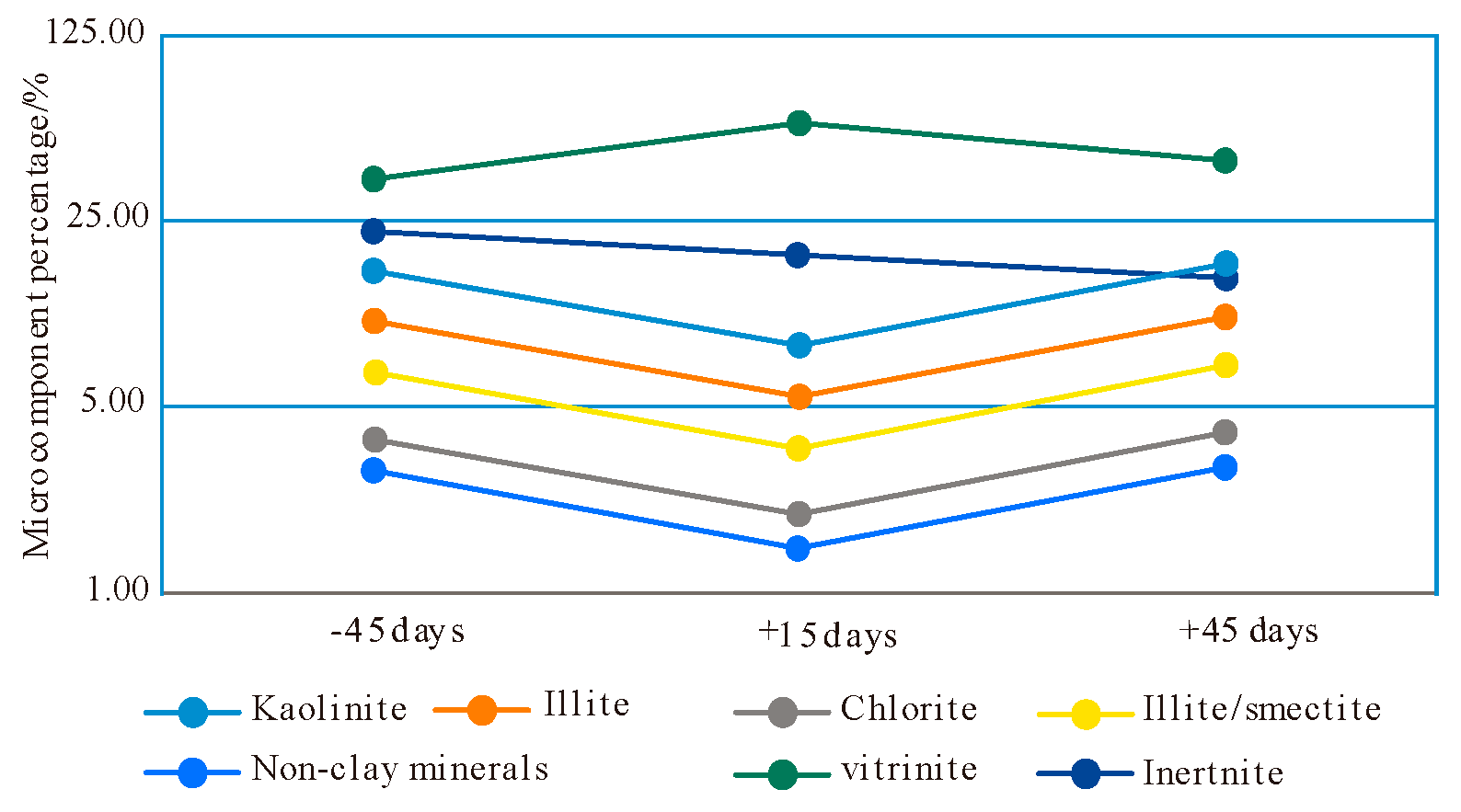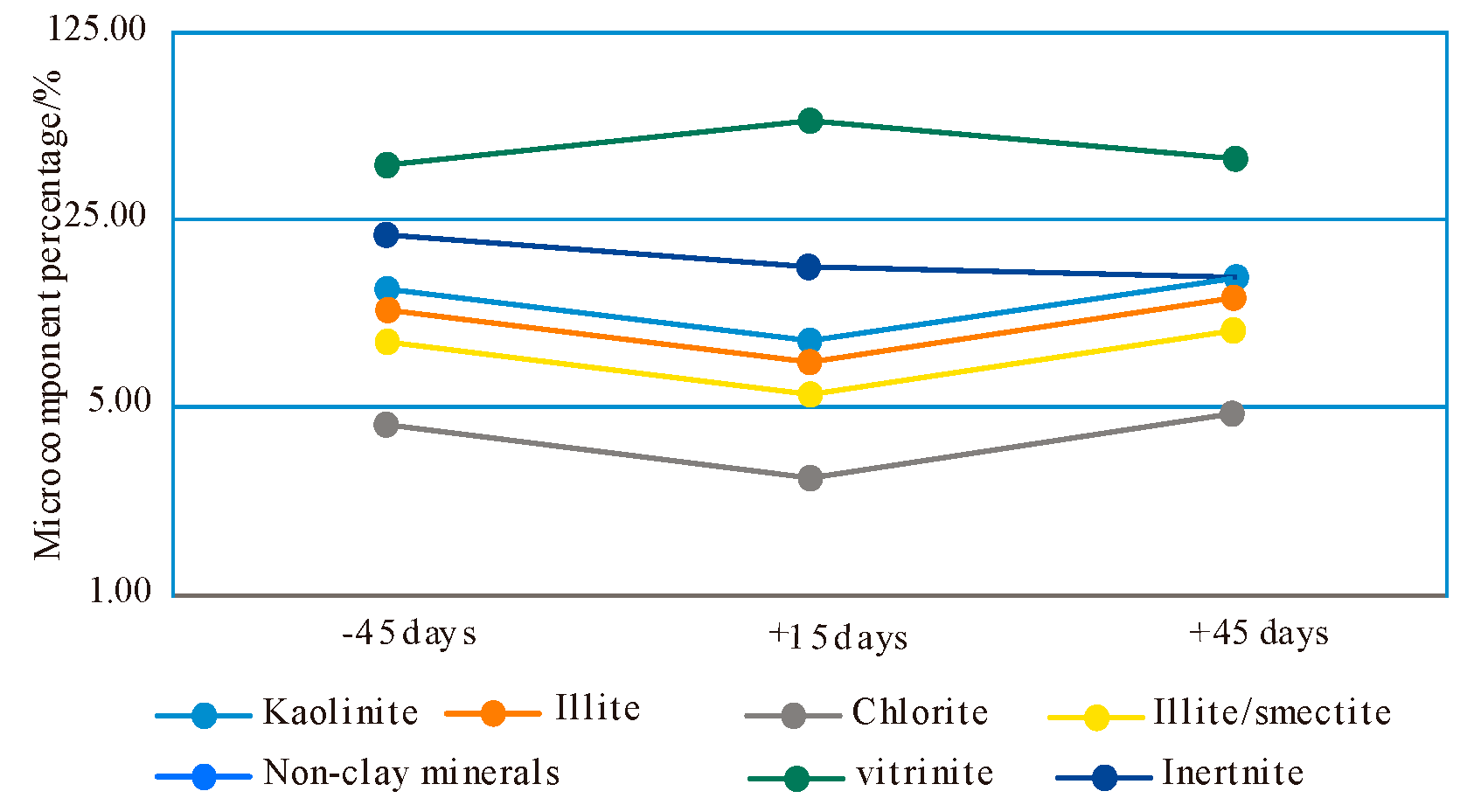Phase Behavior of Fluid Composition in Coalbed Methane Wells Pre- and Post-Workover: An Examination of the Panzhuang Block, Qinshui Basin, Shanxi, China
Abstract
:1. Introduction
2. Geological Background
3. Experiments
3.1. Sampling Method
- (1)
- Water samples must be uniformly collected from coalbed methane production wells in the No. 3 coal seam in the Panzhuang block.
- (2)
- The sampling wells should be located in coal seams with simple structures and wings in folds with similar dip angles.
- (3)
- CBM wells must have a production history of more than 100 days, ensuring that the well is in the gas-water two-phase flow drainage stage, which helps to mitigate the impact of water environment changes caused by drilling and fracturing projects.
3.2. Experimental Method
3.2.1. Analysis of Dissolved Minerals
3.2.2. Characteristic Analysis of Sedimentary Minerals
4. Results
4.1. Dissolved Mineral Analysis Results
4.2. Analysis Results of Precipitated Minerals
5. Discussion
5.1. Analysis of Phase Change of Dissolved Minerals
5.2. Analysis of Stage Changes of Precipitation Minerals
5.3. Mechanism Analysis of Influence on Gas Production Efficiency

6. Conclusions
Author Contributions
Funding
Institutional Review Board Statement
Informed Consent Statement
Data Availability Statement
Conflicts of Interest
References
- Ministry of Natural Resources of China. National Oil and Gas Resources Exploration and Exploitation Bulletin (2020) [EB/OL]. Available online: http://gi.mnr.gov.cn/202109/t20210918_2681270.html (accessed on 18 September 2021).
- Wang, H.; Liu, C. Process parameters design method of drainage gas recovery technology in gas-driven pump for coalbed methane production. J. Pet. Sci. Eng. 2019, 207, 109–167. [Google Scholar]
- Li, S.; Tang, D.; Pan, Z.; Xu, H.; Tao, S.; Liu, Y.; Ren, P. Geological conditions of deep coalbed methane in the eastern margin of the Ordos Basin, China: Implications for coalbed methane development. J. Nat. Gas Sci. Eng. 2018, 5, 392–402. [Google Scholar] [CrossRef]
- Huang, F.S.; Kang, Y.L.; You, L.J.; Li, X.C.; You, Z.J. Massive fines detachment induced by moving gas-water interfaces during early stage two-phase flow in coalbed methane reservoirs. Fuel 2018, 222, 193–206. [Google Scholar] [CrossRef]
- Bai, T.; Chen, Z.; Aminossadati, S.M.; Rufford, T.E.; Li, L. Experimental investigation on the impact of coal fines generation and migration on coal permeability. J. Pet. Sci. Eng. 2017, 159, 257–266. [Google Scholar] [CrossRef]
- Sobczyk, J. A comparision of the influence of adsorbed gases on gas stresses leading to coal and gas outburst. Fuel 2014, 115, 288–294. [Google Scholar] [CrossRef]
- Perera, M.; Ranjith, P. Effects of saturation medium and pressure on strength parameters of Latrobe Valley brown coal: Carbon dioxide, water and nitrogen saturations. Energy 2011, 36, 6941–6947. [Google Scholar] [CrossRef]
- Kang, J.; Elsworth, D.; Fu, X.; Liang, S.; Chen, H. Influence of water on elastic deformation of coal and its control on permeability in coalbed methane production. J. Pet. Sci. Eng. 2022, 208, 109603. [Google Scholar] [CrossRef]
- Wang, G.; Wu, J.; Xiong, D.; Zhang, Z.; Zhao, Y.; Guo, H. Fine stable controlling technologies of water drainage and gas production in the Panhe CBM Gas Field‚ southern Qinshui Basin. Nat. Gas Ind. 2011, 5, 31–34. [Google Scholar]
- Zhang, R.; Shen, F. Discussion of drainage system after workover operation of coalbed methane wells. China Acad. J. Electron. Publ. House Shanxi Coal 2019, 6, 74–78+98. [Google Scholar]
- Kaiser, W.R.; Swartz, T.E.; Hawkins, G.J. Hydrology of the Fruitland formation, san juan basin. In Geologic and Hydrologic Controls on the Occurrence and Productivity of Coalbed Methane, Fruitland Formation, San Juan Basin 1991; Gas Research Institute Topical Report GRI-91/0072; Gas Research Institute: Des Plaines, IL, USA, 1991; pp. 195–241. [Google Scholar]
- Pashin, J.C. Hydrodynamics of coalbed methane reservoirs in the black warrior basin: Key to understanding reservoir performance and environmental issues. Appl. Geochem. 2007, 22, 2257–2272. [Google Scholar] [CrossRef]
- Guo, C.; Qin, Y.; Wu, C.F.; Lu, L.L. Hydrogeological control and productivity modes of coalbed methane commingled production in multi-seam areas: A case study of the Bide-santang basin, western Guizhou, south China. J. Pet. Sci. Eng. 2020, 189, 107039. [Google Scholar] [CrossRef]
- Scott, A.R. Hydrogeological factors affecting gas content distribution in coal beds. Int. J. Coal Geol. 2002, 50, 363–387. [Google Scholar] [CrossRef]
- Bachu, S.; Michael, K. Possible controls of hydrogeological and stress regimes on the producibility of coalbed methane in Upper Cretaceous-Tertiary strata of the Alberta basin, Canada. Am. Assoc. Pet. Geol. Bull. 2003, 87, 1729–1754. [Google Scholar] [CrossRef]
- Li, X.; Fu, X.H.; Ge, Y.Y.; Chang, X.X. Research on sequence stratigraphy, hydrogeological units and commingled drainage associated with coalbed methane production: A case study in Zhuzang syncline of Guizhou province, China. Hydrogeol. J. 2016, 24, 2172–2187. [Google Scholar] [CrossRef]
- Lamarre, R.A. Hydrodynamic and stratigraphic controls for a large coalbed methane accumulation in Ferron coals of east-central Utah. Int. J. Coal Geol. 2003, 56, 97–110. [Google Scholar] [CrossRef]
- Qin, S.; Tang, X.; Song, Y.; Wang, H. Distribution and fractionation mechanism of stable carbon isotope of coalbed methane. Sci. China Earth Sci. 2006, 12, 1252–1258. [Google Scholar] [CrossRef]
- Chen, S.; Tao, S.; Tian, W.; Tang, D.; Zhang, B.; Liu, P. Hydrogeological control on the accumulation and production of coalbed methane in the Anze Block, southern Qinshui Basin, China. J. Pet. Sci. Eng. 2021, 198, 108–138. [Google Scholar] [CrossRef]
- Zhang, S.H.; Tang, S.H.; Li, Z.C.; Pan, Z.J.; Shi, W. Study of hydrochemical characteristics of CBM co-produced water of the Shizhuangnan Block in the southern Qinshui Basin, China, on its implication of CBM development. Int. J. Coal Geol. 2016, 159, 169–182. [Google Scholar] [CrossRef]
- Xian, B.A.; Liu, G.F.; Bi, Y.S.; Gao, D.L.; Wang, L.; Cao, Y.; Shi, B.; Zhang, Z.; Zhang, Z.; Tian, L.; et al. Coalbed methane recovery enhanced by screen pipe completion and jet flow washing of horizontal well double tubular strings. J. Nat. Gas Sci. Eng. 2022, 99, 104430. [Google Scholar] [CrossRef]
- Su, X.B.; Wang, Q.; Song, J.X.; Chen, P.; Yao, S.; Hong, J.; Zhou, F. Experimental study of water blocking damage on coal. J. Pet. Sci. Eng. 2017, 156, 654–661. [Google Scholar] [CrossRef]
- Wei, Y.C.; Li, C.; Cao, D.Y.; Cui, B.L.; Xiang, Y.X. Effect of pulverized coal dispersant on coal in the CBM well-washing technology. J. China Coal Soc. 2018, 7, 1951–1958. [Google Scholar]
- Chen, M.Y.; Chen, X.Y.; Wang, L.; Tian, F.-C.; Yang, Y.-M.; Zhang, X.-J.; Yang, Y.-P. Water adsorption characteristic and its impact on pore structure and methane adsorption of various rank coals. In Environmental Science and Pollution Research; Springer: Berlin, Germany, 2022. [Google Scholar] [CrossRef]
- Wu, C.C.; Yang, Z.B.; Qin, Y.; Chen, J.; Zhang, Z.; Li, Y. Characteristics of hydrogen and oxygen isotopes in produced water and productivity response of CBM wells in western Guizho. Energy Fuels 2018, 32, 11203–11211. [Google Scholar] [CrossRef]
- Yang, Z.; Qin, Y.; Wu, C.; Qin, Z.; Li, G.; Li, C. Geochemical response of produced water in the CBM well group with multiple coal seams and its geological significance-A case study of the Songhe well group in Western Guizhou. Int. J. Coal Geol. 2019, 207, 39–51. [Google Scholar] [CrossRef]
- Qin, Y.; Shen, J.; Shi, R. Strategic Value and Choice on Construction of CMG Industry in China. J. China Coal Soc. 2022, 47, 371–387. [Google Scholar] [CrossRef]
- Wang, Q.W. The Output Mechanism and Control Factors of the Pulverized Coal in Panzhuang Area, Qinshui Basin. Ph.D. Thesis, China University of Mining and Technology, Beijing, China, 2013. [Google Scholar]
- Cao, D.Y.; Guan, Y.B.; Zhang, J.L.; Wu, G.Q.; Wang, C.Y.; Qian, G.M. The Structural Characteristic of the East of Qinshui Coal Field; The Press of Chongqing University: Chongqing, China, 1996; pp. 72–76. [Google Scholar]
- Liu, H.L.; Li, G.Z.; Wang, G.J.; Wang, B. The Geological Characters and Development Prospect of the Coalbed Methane in Qinshui Basin; Petroleum Engineering Industry: Beijing, China, 2008. [Google Scholar]
- Zhang, S.A.; Hua, Z.J.; Zhang, P. The Design Illustration of the Development of Panzhuang Coalbed Methane Project; The Internal Report of Blue Flame Coalbed Methane: Jinchen, China, 2009. [Google Scholar]
- Ye, J.P.; Wu, Q.; Ye, G.J.; Chen, C.L.; Yue, W.; Li, H.Z.; Zhai, Z.R. Study on the coalbed methane reservoir-forming dynamic mechanism in the southern Qinshui basin, Shanxi. Geol. Rev. 2002, 3, 319–323. [Google Scholar]
- Zhang, X.M. Chemical Characteristics and Dynamic Field Analysis of CBM Produced Water in the Southern Qinshui Basin. Master’s Thesis, Henan Polytechnic University, Jiaozuo, China, 2012. [Google Scholar]
- Chinese Industry Standard SL187-96; Technical Regulation of Water Composition Sampling. Ministry of Water Resource of the People’s Republic of China: Beijing, China, 1997.
- Chinese Industry Standard DZ/T 0064.1~0064.80-93; Groundwater Composition Inspection Method. Ministry of Geology and Mineral Resources of the People’s Republic of China: Beijing, China, 1993.
- Pashin, J.C.; Pradhan, S.P.; Vishal, V. Formation Damage in Coalbed Methane Recovery, Formation Damage during Improved Oil Recovery; Gulf Professional Publishing: London, UK, 2018; pp. 499–514. [Google Scholar]
- Mao, Z.Y. Study of Technology and Key Equipment Design Based on CBM Wells Workover Reservoir Protection. Master’s Thesis, China University of Petroleum, Beijing, China, 2018. [Google Scholar]
- Li, Z.C.; Tang, S.H.; Wang, X.F.; Zheng, G.Q.; Zhu, W.P.; Wang, S.S.; Zhang, J.P. Relationship between water chemical composition and production of coalbed methane wells, Qinshui basin. J. China Univ. Min. Technol. 2011, 3, 424–429. [Google Scholar]
- Qin, Z.H. Microbial Community Evolution and Gas Water Interaction Mechanism in the Process of Producing Water from Coalbed Methane Wells. Master’s Thesis, China University of Mining & Technology, Beijing, China, 2021. [Google Scholar]
- Si, L.; Wei, J.; Xi, Y.; Wang, H.; Wen, Z.; Li, B.; Zhang, H. The influence of long-time water intrusion on the mineral and pore structure of coal. Fuel 2021, 290, 119848. [Google Scholar] [CrossRef]
- Liu, H.; Huang, W.H.; Ao, W.H.; Lu, X.X.; Liu, S.P.; Luo, J.L. Controls of coal maceral composition of coal seam 3# and 15# on microfracture in south Qinshui basin. Resour. Ind. 2012, 4, 75–81. [Google Scholar]
- Han, D.X.; Ren, D.Y.; Wang, Y.B.; Jin, K.L.; Mao, H.L.; Qin, Y. Coal Petrology of China; China University of Mining & Technology Press: Beijing, China, 1996; pp. 26–37. [Google Scholar]
- Tao, S.; Tang, D.; Song, H.; Li, S. The influence of flow velocityon coal fines output and coal permeability in the Fukang Block, southern Junggar Basin, China. Sci. Rep. 2017, 7, 14–124. [Google Scholar] [CrossRef]
- Cao, D.Y.; Yuan, Y.; Wei, Y.C.; Liu, S.G.; Li, X.M.; Wang, Q.W. Comprehensive classification study of coal fines genetic mechanism and origin site. Coal Geol. China 2012, 1, 10–12. [Google Scholar]
- Wei, K.Q.; Liu, G.J.; Wang, X.D.; Ma, X.N.; Duan, J.; Chang, F.C. Conventional workover operation technology of coalbed methane. Chem. Enterp. Manag. 2020, 16, 196–197. [Google Scholar]
- Wang, Q. Timeliness Analysis of Coalbed Methane Workover for Reducing Damage to Coal Reservoirs. ACS Omega 2022, 8, 6956–6962. [Google Scholar] [CrossRef] [PubMed]







| Well ID | Ions and Time | −135 Days | −105 Days | −75 Days | −45 Days | −15 Days | +15 Days | +45 Days | +75 Days | +105 Days | +135 Days |
|---|---|---|---|---|---|---|---|---|---|---|---|
| GC-06 | Na+ | 712.10 | 692.30 | 709.40 | 675.00 | 739.00 | 1056.90 | 802.30 | 730.20 | 605.90 | 542.60 |
| Mg2+ | 12.41 | 12.04 | 11.23 | 12.31 | 13.25 | 29.52 | 16.30 | 11.35 | 10.92 | 11.96 | |
| Ca2+ | 14.63 | 13.21 | 14.32 | 13.24 | 21.50 | 42.45 | 32.61 | 19.32 | 13.46 | 13.85 | |
| Cl− | 705.30 | 706.20 | 685.70 | 678.90 | 782.10 | 1042.30 | 843.20 | 679.50 | 680.60 | 673.80 | |
| SO42− | 22.67 | 21.36 | 25.41 | 25.39 | 31.63 | 51.31 | 29.30 | 24.39 | 21.36 | 20.97 | |
| HCO3− | 582.30 | 578.40 | 599.30 | 601.97 | 621.60 | 421.22 | 580.32 | 633.40 | 708.40 | 729.50 | |
| TDS | 1702.30 | 1681.50 | 1678.20 | 1772.00 | 1982.00 | 2563.40 | 2346.20 | 1682.50 | 1681.50 | 1692.10 | |
| GC-09 | Na+ | 1026.90 | 1037.20 | 1007.10 | 987.70 | 1045.30 | 1555.20 | 1042.99 | 975.26 | 977.67 | 935.98 |
| Mg2+ | 35.23 | 39.12 | 42.35 | 41.94 | 54.93 | 51.38 | 21.19 | 14.76 | 14.20 | 15.55 | |
| Ca2+ | 29.34 | 27.66 | 28.53 | 30.96 | 41.23 | 55.21 | 35.89 | 18.62 | 17.50 | 18.21 | |
| Cl− | 392.40 | 370.60 | 372.50 | 351.20 | 373.00 | 854.99 | 766.16 | 583.35 | 404.78 | 375.94 | |
| SO42− | 101.20 | 96.30 | 97.40 | 102.30 | 110.96 | 136.70 | 95.23 | 79.27 | 69.42 | 68.15 | |
| HCO3− | 1601.60 | 1642.90 | 1685.60 | 1633.50 | 1732.00 | 1406.85 | 1592.63 | 1665.16 | 1693.46 | 1703.05 | |
| TDS | 2674.50 | 2596.70 | 2545.70 | 2624.50 | 2822.00 | 3332.42 | 2631.20 | 2479.30 | 2496.70 | 2501.90 | |
| GC-10 | Na+ | 1152.86 | 839.67 | 752.96 | 648.51 | 616.08 | 1456.26 | 297.54 | 279.65 | 236.52 | 197.18 |
| Mg2+ | 9.06 | 7.82 | 6.75 | 6.48 | 6.61 | 10.41 | 6.43 | 6.02 | 5.96 | 5.94 | |
| Ca2+ | 24.08 | 21.02 | 20.96 | 19.53 | 19.73 | 31.25 | 18.45 | 18.12 | 18.02 | 18.69 | |
| Cl− | 905.59 | 580.66 | 490.35 | 407.98 | 416.14 | 1186.56 | 264.48 | 175.34 | 198.36 | 210.78 | |
| SO42− | 24.65 | 23.65 | 22.65 | 21.16 | 21.37 | 32.05 | 17.98 | 18.16 | 18.25 | 18.28 | |
| HCO3− | 1665.35 | 1635.69 | 1662.25 | 1690.05 | 1673.15 | 1342.75 | 1712.85 | 1721.30 | 1728.56 | 1736.60 | |
| TDS | 3011.50 | 2503.74 | 2102.45 | 1989.30 | 1991.29 | 3210.63 | 1492.45 | 1451.33 | 1406.96 | 1349.00 |
| Well ID | Time (Day) | Kaolinite | Illite | Chlorite | Illite/Smectite | Non-Clay Minerals | Vitrinite | Inertnite |
|---|---|---|---|---|---|---|---|---|
| GC-06 | −45 days | 16.74 | 10.65 | 3.80 | 6.85 | 2.86 | 36.50 | 22.60 |
| +15 days | 8.59 | 5.47 | 1.95 | 3.52 | 1.47 | 60.20 | 18.80 | |
| +45 days | 17.28 | 11.00 | 3.93 | 7.07 | 2.96 | 42.53 | 15.23 | |
| GC-09 | −45 days | 13.79 | 11.49 | 4.21 | 8.81 | 0.00 | 40.10 | 21.60 |
| +15 days | 8.75 | 7.29 | 2.67 | 5.59 | 0.00 | 59.20 | 16.50 | |
| +45 days | 15.27 | 12.73 | 4.67 | 9.76 | 0.00 | 42.24 | 15.34 |
| Well ID | Ions and Time | Mean Square Error of Each Ion from 15 to 105 Days after Workover | The Ratio of Daily Gas Production between 105 Days after Workover and 105 Days before Workover (%) | The Ratio of Daily Water Production between 105 after Workover and 105 Days before Workover (%) |
|---|---|---|---|---|
| GC-06 | Na+ | 171.64 | 76 | 80 |
| Mg2+ | 9.39 | |||
| Ca2+ | 11.61 | |||
| Cl− | 181.69 | |||
| SO42− | 14.34 | |||
| HCO3− | 110.42 | |||
| TDS | 458.92 | |||
| GC-09 | Na+ | 317.09 | 86 | 82 |
| Mg2+ | 19.55 | |||
| Ca2+ | 18.31 | |||
| Cl− | 138.50 | |||
| SO42− | 29.65 | |||
| HCO3− | 133.22 | |||
| TDS | 455.08 | |||
| GC-10 | Na+ | 674.21 | 93.2 | 92 |
| Mg2+ | 2.42 | |||
| Ca2+ | 7.49 | |||
| Cl− | 559.87 | |||
| SO42− | 8.07 | |||
| HCO3− | 216.16 | |||
| TDS | 1004.07 |
Disclaimer/Publisher’s Note: The statements, opinions and data contained in all publications are solely those of the individual author(s) and contributor(s) and not of MDPI and/or the editor(s). MDPI and/or the editor(s) disclaim responsibility for any injury to people or property resulting from any ideas, methods, instructions or products referred to in the content. |
© 2024 by the authors. Licensee MDPI, Basel, Switzerland. This article is an open access article distributed under the terms and conditions of the Creative Commons Attribution (CC BY) license (https://creativecommons.org/licenses/by/4.0/).
Share and Cite
Wang, Q.; Yan, Q.; Zhang, Y.; Xing, X.; Hao, C. Phase Behavior of Fluid Composition in Coalbed Methane Wells Pre- and Post-Workover: An Examination of the Panzhuang Block, Qinshui Basin, Shanxi, China. Appl. Sci. 2024, 14, 7207. https://doi.org/10.3390/app14167207
Wang Q, Yan Q, Zhang Y, Xing X, Hao C. Phase Behavior of Fluid Composition in Coalbed Methane Wells Pre- and Post-Workover: An Examination of the Panzhuang Block, Qinshui Basin, Shanxi, China. Applied Sciences. 2024; 14(16):7207. https://doi.org/10.3390/app14167207
Chicago/Turabian StyleWang, Qingwei, Qiang Yan, Yan Zhang, Xiafan Xing, and Cailian Hao. 2024. "Phase Behavior of Fluid Composition in Coalbed Methane Wells Pre- and Post-Workover: An Examination of the Panzhuang Block, Qinshui Basin, Shanxi, China" Applied Sciences 14, no. 16: 7207. https://doi.org/10.3390/app14167207







